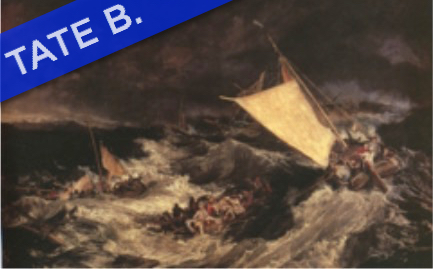Turner’s Undine Giving the Ring to Masaniello, Fisherman of Naples (c.1845-6)

Turner, Undine Giving the Ring to Masaniello, Fisherman of Naples (c.1845-6) Oil on canvas. Tate Britain, London.
Click image to enlarge.
In 1846 Turner exhibited this painting at the Royal Academy. Its apparent subject matter is complex because it mysteriously mixes the plot of a Romantic novel with historical fact. Undine is a water sprite who marries a mortal knight to gain a soul, here replaced by Masaniello who had led a fisherman's revolt in Naples in 1647. Turner, a keen angler, is said to have identified with the fisherman as he might have with Undine too.1
Click next thumbnail to continue

Top: Turner, Undine Giving the Ring to Masaniello
Middle: Turner, Self-portrait (17980-1800), detail of detail below
Bottom L: Detail of Self-portrait
Click image to enlarge.
As shown before in Turner's Fifth Plague of Egypt (1800) the round forms so common in Turner's art often represent an eye close-up (top and middle). The dark skin under his eyes (bottom), visible in both extant self-portraits, became a sign of self-identity in his art, often indicating that we are on the inside of his mind looking outwards through his "eye". That is why the scene is in the dark while the light is beyond, outside. The circle, moreover, balances between the chaotic waters of the deep, a biblical symbol of formlessness before creation, and the abode of true and everlasting forms in the sky. Thus the struggling figures in the sea convey within art's traditions Turner's own creative struggle. His subsequent resolution of this creative problem into a finished painting is symbolized by transcendence and expressed through the passing of the gold ring from the imaginal world of the sprite to the exterior "historical" world of Masaniello. In this way, then, inner and outer are united in "marriage" as they must be in art.
Click next thumbnail to continue

Top: Detail of "finger" in Turner's Undine Giving the Ring to Masaniello
Bottom: Diagram of Turner's Undine Giving the Ring to Masaniello
Click image to enlarge.
Our argument that creation is once again Turner's theme is further supported by the previously unseen presence of the artist's spectral finger (top). Life-size, it "touches" the lower edge of the image (bottom) and thereby "paints" it. It signifies an artist's touch.2 What it is also intended to represent within the scene is not even clear other than some debris in the water.3
Turner's late paintings baffled his contemporaries and still mystifies experts. However, by presuming that Turner followed art's traditions and did not overturn them, you can make some sense of the oddities in his art - and that's progress.
And for more on Turner's hidden visions, see our post on The Poetry of Turner's Eyesight.
More Works by Turner
Notes:
1. David Bayley Brown in Late Turner (London: Royal Academy) 2014, p. 189
2. See the theme Pointing and Touch.
3. The presence of the artist's eye and hand (symbolizing the necessity of combining intellect with craft) is so common in art generally that we list "Hand and Eye" as a separate theme under "Eye" in the column at far left above.
Original Publication Date on EPPH: 01 Dec 2014. © Simon Abrahams. Articles on this site are the copyright of Simon Abrahams. To use copyrighted material in print or other media for purposes beyond 'fair use', you must obtain permission from the copyright owner. Websites may link to this page without permission (please do) but may not reproduce the material on their own site without crediting Simon Abrahams and EPPH.


